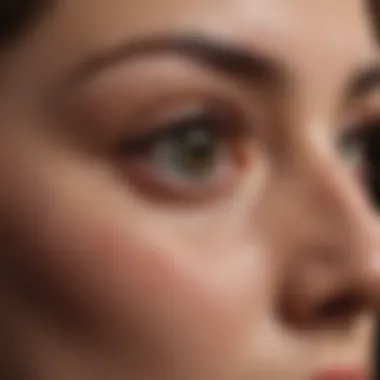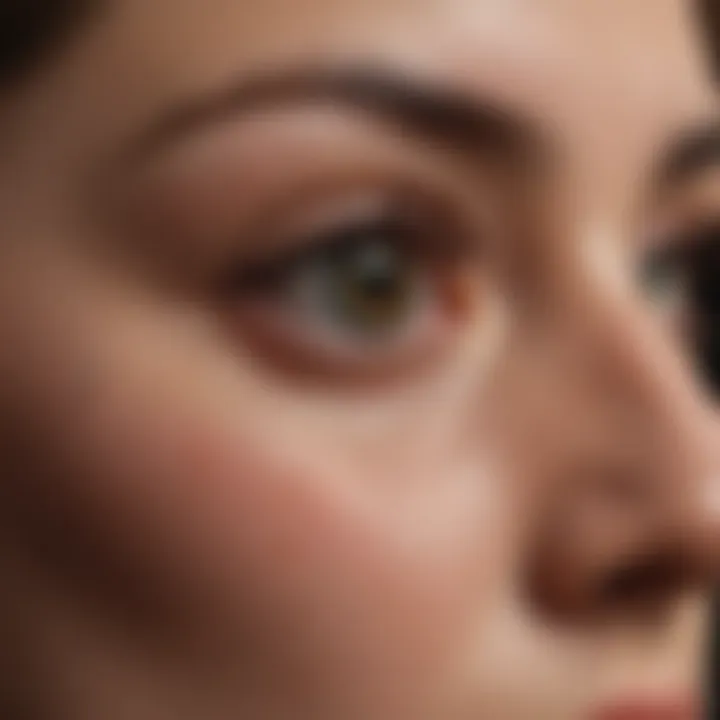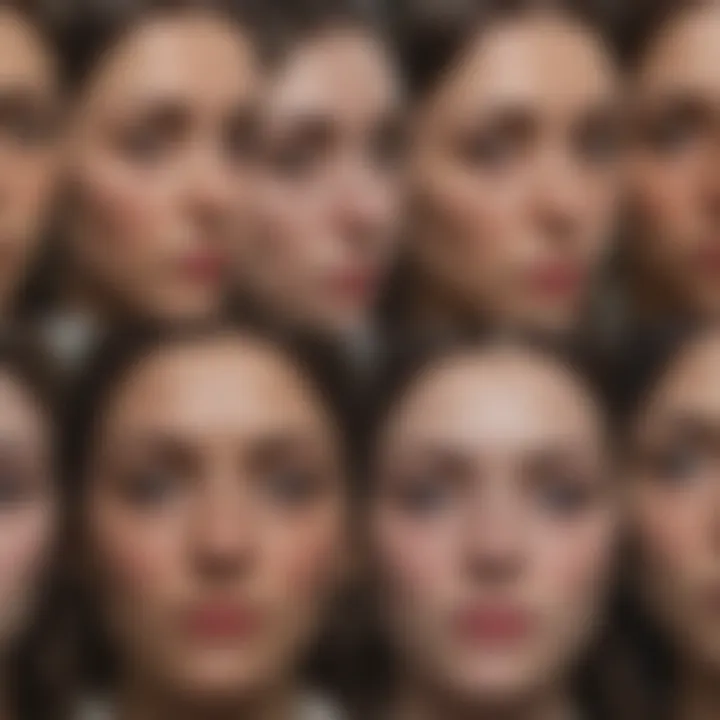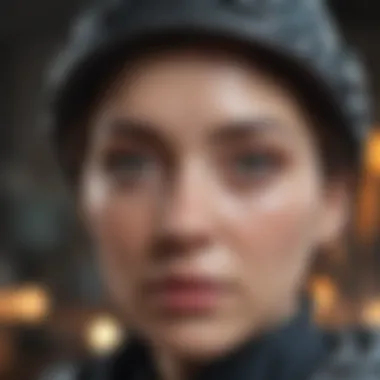Identifying Artwork: Methodologies and Criteria


Intro
The identification of artwork is a nuanced process that demands a combination of keen observation, historical knowledge, and scientific techniques. Within the realm of art, the quest to ascertain the authenticity, origin, and significance of a piece is crucial for scholars, collectors, and institutions alike. The amalgamation of various methodologies fosters a holistic understanding of art pieces that transcends mere aesthetic appreciation. As the landscape of art evolves, so too does the forensic analysis that accompanies it.
Research Overview
Summary of Key Findings
Research indicates that a successful identification of artwork revolves around several primary components: historical context, stylistic elements, technical characteristics, and provenance. Each of these aspects informs the narrative behind a piece, providing a multidimensional perspective that enhances its valuation and appreciation. Recent studies have shown that technological advances such as imaging techniques and databases have significantly improved identification accuracy.
- Historical Context: Understanding the period in which the artwork was created is fundamental. It informs the viewer about the socio-political climate that may have influenced the artist.
- Stylistic Elements: Analyzing the visual language and techniques employed in the artwork aids in placing it within certain art movements or schools.
- Technical Characteristics: This involves using scientific methods such as pigment analysis or material sourcing that lend credibility to the artwork's age and originality.
- Provenance: Documenting the ownership history of an artwork often reveals its significance and can affirm its authenticity.
"Each artwork is a window into its time, revealing the thoughts and sentiments of the era through which it has passed."
Relevance to Current Scientific Discussions
In today’s digital age, the collaboration between art historians, scientists, and technology experts is increasingly vital. This interdisciplinary approach not only enhances the ability to identify works of art but also contributes to broader discussions surrounding the preservation of cultural heritage. The fusion of traditional art analysis techniques with contemporary technologies allows for new insights that were previously unattainable. This is particularly relevant in cases of disputed ownership, where historical documentation may be incomplete or lost.
Methodology
Research Design and Approach
The research design employed in artworks identification typically includes both qualitative and quantitative methods. Close visual examination is complemented by laboratory analysis, allowing for a comprehensive understanding of an art piece. The amalgamation of these approaches forms a robust framework for evaluating authenticity.
Data Collection and Analysis Techniques
Data collection techniques often range from archival research and interviews with experts to the use of advanced imaging technologies. Techniques such as infrared reflectography or X-ray fluorescence can uncover layers beneath the surface, revealing underdrawings or materials used. Analytical techniques are subsequently employed to assess gathered data, drawing connections between identified characteristics and historical records.
Preface to Art Identification
Art identification is a crucial process that involves recognizing and authenticating artworks. This article aims to shed light on the methodologies and principles that underpin this field. Understanding art identification is not merely an academic exercise; it has real-world implications for collectors, historians, and the art market as a whole.
The identification process encompasses a range of elements, such as historical context, technical characteristics, and provenance. Each aspect plays a vital role in determining the authenticity and significance of an artwork. Furthermore, the ability to accurately identify art helps preserve cultural heritage and informs current artistic practices.
Definition and Importance
Art identification refers to the systematic process of verifying and categorizing artworks. This discipline employs various methods and tools to establish an artwork's creator, date, and historical context. The importance of effective art identification cannot be overstated. It influences buying decisions in the art market, informs legal considerations involved in ownership disputes, and aids in scholarship.
A clear definition of art identification also helps to distinguish between original works and reproductions or forgeries. It serves as a framework through which art historians and collectors can evaluate an artwork's cultural and financial value.
Historical Development
The historical development of art identification has evolved over centuries, responding to changing societal values and technological advances. Initially, art identification relied heavily on stylistic analysis and expert opinion. Art historians utilized their knowledge of styles and periods to identify works and their creators.
However, as forgeries and misattributions became more common, there arose a need for more rigorous methodologies. This led to the integration of scientific analysis, including techniques such as pigment analysis and radiographic imaging. These advancements allowed experts to examine the physical characteristics of artworks, leading to more accurate identifications.
In recent years, the interplay between technology and art has introduced new dimensions to art identification. From digital databases to machine learning algorithms, modern tools are reshaping how artworks are identified and understood.
The Role of Context
Understanding the role of context in art identification is crucial for acknowledging how artworks interact with their surrounding influences. Context encompasses various elements, including cultural backgrounds, historical settings, and social dynamics. These factors not only shape the creation of an artwork but also determine the methods used for its identification. Considering context offers benefits such as deeper insights into the artwork's meaning and interpretation.
Artworks are not produced in a vacuum. Each piece reflects the period in which it was created and embodies unique narratives, techniques, and ideologies pertinent to its time. Thus, engaging with the context allows one to appreciate the numerous layers of significance captured within the artwork. The identification process is more than simply attributing a name; it involves recognizing the intersection of various influences that inform and inspire the artist.
Cultural Background
Cultural background plays a significant role in how artworks are created, perceived, and identified. Each culture holds particular values, beliefs, and rituals that can profoundly affect artistic expression. For example, Indigenous art may incorporate specific symbols that convey spiritual meanings pertinent to that group's identity. Identifying these cultural indicators is essential for an accurate understanding of the artwork.
To effectively analyze the cultural background of an artwork, one can consider the following aspects:
- Symbolism: Objects and colors may represent distinct cultural narratives.
- Tradition: Techniques passed down through generations can influence the artist's methods.
- Materials: The choice of medium often reflects available resources within a culture.
A thorough understanding of these elements allows for a more nuanced interpretation of the artwork and its intended message.


Historical Significance
The historical significance of an artwork is equally crucial for its identification. Each piece can serve as a historical record, providing insights into the events, movements, and shifts of its time. For instance, art created during wartime often communicates themes of struggle or resilience, thus highlighting the tensions of that era. By contextualizing artworks within their historical timeline, art historians can uncover the stories that inform each creation.
Key considerations for analyzing historical significance include:
- Historical Events: Specific historical moments can directly influence artistic themes.
- Social Movements: Art can reflect the sentiments surrounding social change, such as feminism or civil rights.
- Artistic Movements: Understanding movements like Surrealism or Impressionism provides context for stylistic choices.
Recognizing these historical elements enhances the viewer's comprehension of the artwork, connecting it to broader narratives within art history.
Technical Aspects of Artwork
Understanding the technical aspects of artwork is crucial for proper identification and appreciation. The medium, materials, and techniques employed by artists offer insights into not just the creation process but also the era and cultural context in which the artwork was produced. Analyzing these elements assists in distinguishing between authentic works and forgeries, as certain materials or styles may signify specific periods or artists.
Materials and Mediums
The choice of materials and mediums plays a fundamental role in artwork. Various materials, such as oil paint, acrylics, watercolors, and pastels, influence the texture, durability, and overall aesthetic of a piece. Each material carries unique characteristics that can provide clues about the artist’s intent and era.
For example:
- Oil Paint: Known for its richness in color and ability to be layered, it was predominant during the Renaissance.
- Acrylic Paint: More modern, it allows for quicker drying times and versatile techniques, appearing prominently in the 20th century.
Investigating these materials can lead to the discovery of an artwork’s provenance. Chemical analyses can identify whether a specific pigment was available during the artist's time, further corroborating the authenticity of a piece. This aspect directly links materials to historical context, enhancing the understanding of the work.
Techniques and Styles
Techniques and styles are equally significant in art identification. Different eras and movements are defined by particular techniques that artists adopt. Understanding these techniques can provide context about the piece's creation.
For example, the Impressionists employed loose brushwork and a focus on light, while the Cubists broke forms into geometric shapes.
Moreover, various styles can indicate an artist's education or influences.
- Hatching and Cross-Hatching: Techniques used in drawing can hint at influences from earlier masters or particular cultural movements.
- Chiaroscuro: The technique of using strong contrasts between light and dark can indicate connections to the Baroque period.
The integration of these techniques into the identification process highlights how artists interpret their surroundings and evolve their styles over time.
"Art is a reflection of the technical progress and cultural currents of its time."
Notably, changes in technique can signal shifts in artistic movements, offering a comprehensive view of the evolution of art.
Methodologies for Artwork Identification
Understanding the methodologies for artwork identification is vital in the study of art. Identifying artwork involves a detailed analysis of visual elements, materials, historical context, and sometimes the application of scientific techniques. The importance lies not only in cataloging artworks but also in preserving cultural heritage and ensuring authenticity.
Identifying an artwork contributes to its value and the understanding of artistic movements and periods. Proper methodology provides clarity in distinguishing between genuine pieces and forgeries. A systematic approach to artwork identification can aid researchers and conservators in making informed decisions regarding art restoration and provenance verification.
Visual Analysis
Visual analysis is a fundamental method in artwork identification. By closely examining an artwork, one can gain insights into its style, composition, and the techniques used by the artist. This type of analysis involves assessing several visual components. Key aspects to consider include:
- Color palette: The selection of colors can reflect the period in which the work was created.
- Composition: Analyzing the arrangement of elements within the artwork helps discern the artist's intent and stylistic tendencies.
- Brushwork: Examining how paint is applied reveals the artist's techniques and possibly hints at their identity.
- Subject matter: Understanding the themes and motifs present in the artwork informs its historical context.
Through visual analysis, experts can identify distinct styles associated with certain artists or movements, contributing to establishing the authenticity of a work. Visual characteristics can serve as critical indicators during the identification process. Furthermore, art historians often rely on comparative techniques, utilizing existing databases or collections for further reference.
Scientific Analysis
Scientific analysis provides a different layer of understanding in artwork identification. This method employs technology to reveal data that is not readily visible through visual inspection alone. Scientific analysis covers various techniques, including:
- X-ray imaging: This technique helps visualize the layers of paint and any alterations made over time.
- Infrared reflectography: Useful for examining underlying sketches and underdrawings that inform the artwork's development.
- Pigment and canvas analysis: Testing the composition of pigments and materials used in the artwork aids in verifying authenticity and dating.
- Varnish analysis: The composition of varnish can indicate the period when it was applied, thereby offering clues about the artwork’s history.
Employing scientific methods does not replace visual analysis; rather, it complements it. The combination of both methodologies enhances the likelihood of authenticating artworks accurately. In an age where forgery techniques are increasing in sophistication, the integration of scientific analysis is becoming more essential.
"Art identification is not merely an art; it is a science shaped by the fusion of tradition and technology."


By employing both visual and scientific methodologies, researchers can build a comprehensive understanding of an artwork's identity and history, further enriching the field of art identification.
The Interdisciplinary Approach
In the realm of art identification, the interdisciplinary approach stands as a pivotal methodology. It connects diverse fields, enhancing the depth of understanding and accuracy in identifying artworks. By integrating knowledge from disciplines such as art history, chemistry, and digital technology, experts gain access to a holistic view of the artwork. This integration leads to more informed decisions regarding provenance, authenticity, and context.
Collaborative efforts between artists, scientists, and technologists foster innovation in methods. The result is a more rigorous analysis that considers not only aesthetic elements but also scientific data. This is crucial in today’s complex art market, where forgeries and misattributions can undermine the integrity of valuable works.
"By merging various fields of knowledge, we unlock new layers of understanding in the art world."
An interdisciplinary framework not only broadens the analytical lens but also addresses the limitations inherent in any single discipline. For instance, while art historians may excel in contextualizing a piece within its historical background, they may lack the scientific expertise required to analyze materials or examine physical evidence. Therefore, this collaborative environment ensures that multiple angles are considered, leading to a more comprehensive assessment.
Collaboration with Science
Scientific collaboration plays a vital role in art identification. Chemists and materials scientists employ techniques such as chromatography and mass spectrometry to analyze pigments and other materials used in artworks. This scientific scrutiny can reveal crucial details regarding the era in which the artwork was created and whether the materials align with established historical knowledge.
These techniques often identify specific compounds that link an artwork to a particular artist or school. For example, the discovery of synthetic pigments in a painting may indicate it was created after those pigments became commercially available. Without scientific testing, conclusions based solely on visual observation would miss these critical aspects.
Moreover, scientific analysis can assist in identifying fakes and forgeries by revealing discrepancies in materials and methods used. This aspect is essential in protecting collectors from acquiring inauthentic pieces, thus preserving the value and integrity of original art.
Integration of Technology
The integration of technology into art identification processes has transformed the field dramatically. Tools such as infrared reflectography, X-ray fluorescence, and 3D imaging allow experts to uncover layers of information that are invisible to the naked eye. These technologies enable a more thorough examination of an artwork’s structure, paint application, and even its previous restoration efforts.
Digital databases and machine learning algorithms also contribute significantly. Specialists can now analyze patterns and compare artworks against extensive databases of known works. This not only accelerates the identification process but also enhances accuracy.
With the advent of virtual reality and augmented reality, the experience and accessibility of art identification have further evolved. These technologies provide immersive experiences that can engage audiences, allowing them to explore artworks and their histories without needing physical presence.
Thus, by bridging technology with traditional art analysis, a richer and more accurate understanding of artworks emerges.
Through cooperation and tech advancements, the landscape of art identification continues to evolve. This ongoing process enhances our ability to both appreciate and validate the significance of artworks.
Provenance and Ownership
Understanding provenance and ownership is essential in the field of art identification. Provenance refers to the history of an artwork, tracing its ownership back to its origin, while ownership concerns the legal rights associated with the artwork. Both factors play a critical role in verifying authenticity, establishing value, and recognizing cultural significance.
When addressing provenance, it is important to consider how detailed documentation can support claims of authenticity. Artworks often possess a documented history that helps to clarify their origin. Such documentation might include exhibitions, sales records, and previous ownership details. Art historians and collectors rely heavily on this information, as it provides critical insights into how the artwork has been perceived and valued over time. Moreover, determining the provenance can reveal connections between artworks, artists, and historical events, adding layers of meaning to the piece.
The Importance of Provenance
Provenance serves multiple purposes in the art world. First, it allows for the authentication of artworks, helping to distinguish genuine pieces from forgeries. This step is crucial in a market where the value of art can vary significantly based on its perceived legitimacy. An established provenance can increase an artwork's marketability, providing potential buyers with confidence in their investment.
Secondly, provenance contributes to scholarship within art history. It fosters a deeper understanding of the cultural and historical context of a piece, tying it into broader narratives of art movements and social trends. Scholars utilize provenance to explore connections between different artists or styles, enhancing the academic value of the work.
Moreover, understanding provenance can aid in resolving disputes over ownership. Issues often arise regarding whether an artwork has been unlawfully acquired or is subject to restitution claims. An accurate and comprehensive provenance can provide clarity in these situations, ensuring that rightful ownership is established.
Legal Implications
The legal implications of artwork ownership often intersect with provenance. Ownership laws vary significantly across jurisdictions, complicating rightful claims. For instance, if an artwork is found to be stolen, its provenance must offer adequate proof that the current owner acquired it legally. Legal considerations can also play a significant role in the market by impacting an artwork's sale or valuation.
Art collectors should be aware that lacking clear provenance can lead to significant legal risks. In some cases, artwork might be subject to restitution claims from families affected by historical injustices. Therefore, having documented provenance safeguards not only the legality of the artwork but also its market value.
Challenges in Art Identification
In the complex world of art, identifying a piece accurately can be fraught with difficulties. Understanding the challenges in art identification is crucial for scholars, collectors, and quality assurance professionals. This section emphasizes the necessity of recognizing these hurdles, as they significantly influence the appreciation, valuation, and preservation of artworks.
Forgeries and Misattributions
Forgeries pose one of the most prominent challenges in art identification. An expert may encounter paintings or sculptures that mimic the style of renowned artists but are, in fact, creations of lesser-known or fraudulent figures. The consequences of failing to identify these forgeries can be severe, leading to misinformed purchases and tarnished reputations. To combat this issue, art historians and appraisers must rely on rigorous methodologies that include visual analysis, provenance research, and scientific testing.
Misattributions are another significant concern. Sometimes, an artwork is mistakenly assigned to an artist to whom it does not belong. This can happen due to a lack of documentation, similarities in style, or even historical errors. Each misattributed piece can lead to profound implications. The artwork may lose its historical significance or value. Correcting such errors requires a collaborative approach, involving expertise across various fields, including art history, conservation science, and even law.
"Accurate identification of artwork is vital for preserving cultural heritage and ensuring fair valuation."


Technological Limitations
Technological advancements play a pivotal role in the identification of art, but they are not without limitations. While tools such as infrared imaging, X-ray fluorescence, and pigment analysis have transformed the landscape, they can only provide part of the puzzle. Each method has its scope and may not capture everything necessary for full identification.
For instance, scientific testing can reveal the composition of materials but may not clarify the artist’s intention, context, or stylistic nuances. In addition, the accessibility of technology can vary greatly. Not all institutions possess the resources to employ advanced methods. This disparity can skew results, leading to inconsistent identification outcomes across various regions and institutions.
Moreover, there is a wave of developing technologies that promise better results. However, they often require additional testing and validation. So, experts must not only adopt new methods but also critically evaluate their effectiveness and limitations. This ongoing challenge shapes how we understand and identify artwork today.
The Future of Artwork Identification
The future of artwork identification emerges as a pivotal intersection of culture, science, and technology. Its significance cannot be overstated. As the art world continues to evolve, the methods for identifying artwork must adapt to accommodate shifts in creativity and innovation. The increasing complexity of forgeries and the additional layers of art authenticity require enhanced strategies for verification. Emerging technologies promise a transformative impact not only in verifying authenticity but also in understanding context.
Emerging Technologies
A range of advanced technologies is redefining how artwork is identified. Tools such as artificial intelligence play a major role. Algorithms can analyze styles and techniques at a staggering speed, allowing for quicker comparisons across vast databases of art. Machine learning provides models that learn from past identifications, improving precision over time.
Additionally, imaging techniques, including multispectral imaging and X-ray fluorescence, allow for deeper physical analysis. These methods unveil layers beneath the surface of paintings that may hold historical significance or reveal alterations made by previous custodians. The ability to create non-invasive evaluations enhances trust in the identification process while preserving the integrity of the artwork.
Key elements to consider about these technologies include:
- Real-time data analysis: Rapid assessment capabilities lead to timely identification and possibly inform market value.
- Collaborative databases: Global access to a shared repository of art characteristics and histories can prevent misattributions.
- Cost-effectiveness: As technologies become more accessible, institutions that once relied on expensive expert evaluations can turn to automated processes that democratize art identification.
Expanding the Field
The expansion of the field of artwork identification is a reflection of broader cultural, scientific, and technological trends. Along with technological advancements, interdisciplinary collaboration remains vital. Researchers from different fields, such as conservation science and forensic science, contribute unique perspectives that enhance the identification process. This openness fosters a richer understanding of artworks.
Programs in educational institutions increasingly incorporate coursework in art technology and forensic analysis. Students exposed to diverse methodologies acquire the skills needed for modern challenges in artwork identification. Their understanding bridges the gap between traditional art history and contemporary verification methods, thus enriching the research landscape.
The expansion fosters worldwide collaboration among institutions, encouraging dialogue and partnerships. This interconnectedness enhances access to information, allowing for a more robust dialogue across cultures and art forms.
Case Studies in Artwork Identification
Case studies in artwork identification serve as vital illustrations of the methodologies and approaches discussed throughout this article. They offer concrete examples that underpin theoretical frameworks and highlight the practical applications of various identification techniques. In the realm of art history, case studies are not merely supplementary; they are essential for understanding the complexities involved in authenticating and contextualizing works of art. The deep dive into both historical examples and modern discoveries allows for a better comprehension of how art identification evolves in response to contemporary challenges and advancements.
Historical Examples
Historical examples provide a rich context for understanding traditional art identification techniques. One notable case is the identification of Leonardo da Vinci’s Salvator Mundi. This painting, long considered lost, was the subject of intense scrutiny when it surfaced in recent years. Experts utilized visual analysis, examining brush strokes and stylistic elements consistent with da Vinci's other works. Scientific methods, such as pigment analysis and infrared reflectography, were also employed to determine the painting's layers and original composition. This case underscores the significance of an interdisciplinary approach, as art historians collaborated with scientists to validate the artwork's authenticity.
Another compelling case involves the attribution of van Gogh’s paintings. Over the years, experts have utilized provenance research and documentary evidence to clarify the authenticity of many works. For example, van Gogh's Portrait of Dr. Gachet had a contested history. Examining auction records and previous owners helped establish a clearer timeline, shedding light on its authenticity.
Modern Discoveries
In contemporary art identification, modern discoveries often hinge on advanced technologies. A prime example is the use of artificial intelligence in identifying artworks. The Art Recognition project blends neural networks with machine learning to analyze style and techniques across various media. This initiative provides insights into newly found pieces and assesses their similarity to known works.
Another recent case is the identification of a previously unknown painting by Banksy. This work, uncovered in a wall in Bristol, drew immediate attention. The identification process involved social media analysis to trace provenance, cross-referencing photographic evidence with existing Banksy pieces. The successful authentication of this piece highlights the evolving methods that incorporate technology and community engagement in the identification process.
"Case studies reveal the intricate layers of art identification, blending historical knowledge with modern methods, allowing for enriched understanding of art’s legacy."
The exploration of these case studies showcases the importance of integrating various methodologies in the identification of artworks. They provide critical insights into the ongoing challenges and advances in the field, making them invaluable for students, researchers, educators, and professionals alike.
Ending
In analyzing the process of artwork identification, it becomes clear that a structured approach is essential. The significance of concluding sections in academic discourse lies in their ability to recapitulate the main findings, clarify the implications of these findings, and suggest further areas for exploration. In this article, we have outlined crucial aspects of identifying artwork, which includes historical context, technical characteristics, and the role of provenance.
The conclusive analysis has highlighted several benefits of rigorous art identification methodologies. Firstly, an accurate identification can prevent misattributions, thereby preserving the integrity of art history. Additionally, it encourages a deeper appreciation of artists and their works, providing insights into their materials and techniques. Moreover, understanding the provenance of artworks supports ethical considerations in the art market, ensuring that ownership issues are addressed responsibly.
Ultimately, the topic's importance transcends academic curiosity; it is pertinent for collectors, museum professionals, and even casual art enthusiasts. The systematic approach we have discussed is not just variations of old techniques but rather an evolving framework that adapts with new technologies and methodologies, shaping the future of art scholarship.
Summary of Key Points
- The methodology of artwork identification encompasses various factors such as technical analysis, provenance assessment, and historical context.
- Key benefits include preventing misattribution, enhancing the understanding of artworks, and addressing ethical ownership issues.
- Integration of emerging technologies and interdisciplinary methods increases the accuracy of identifying artworks in contemporary practice.
Future Considerations
Future considerations in the scope of artwork identification should be directed towards the integration of advanced technological solutions and the deepening of interdisciplinary collaborations. The advent of artificial intelligence and machine learning holds potential for revolutionizing visual analysis techniques. These tools could assist in identifying patterns and features otherwise overlooked by traditional methods.
Moreover, there should be an ongoing dialogue among art historians, scientists, and technologists. This collaboration will foster innovation in methodologies that could enhance the accuracy and depth of artwork analysis. As the field progresses, continuing education in these intersecting areas will equip professionals with necessary skills to navigate the complexities of art identification in the digital era.
In summary, the field of art identification is dynamic and ripe with opportunities for growth. By adhering to a structured analytical approach, future efforts can greatly impact both the study and appreciation of art in society.



